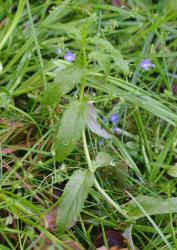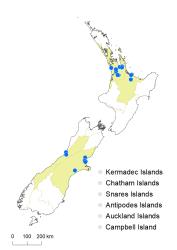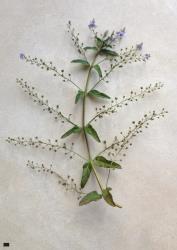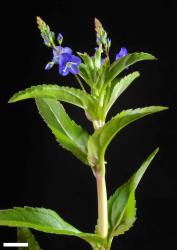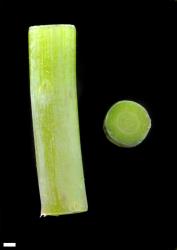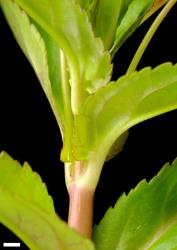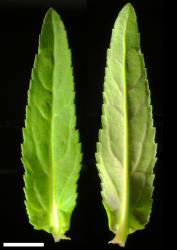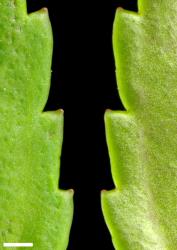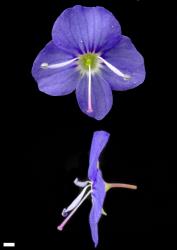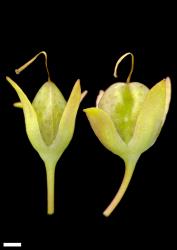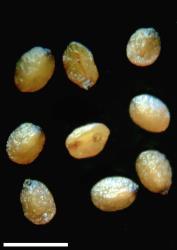- Taxon
- Gallery
Perennial herb to 0.8 m tall. Stems decumbent to ascending (stout, solid, with adventitious roots at nodes in contact with the ground or submerged), glabrous. Leaf bud obscure; leaves separating while small, opposite-decussate, erecto-patent to spreading; lamina thin, linear-lanceolate to lanceolate, or elliptic to narrowly oblong, 20–90 mm long, 5–20 mm wide, dull green above, pale green or green beneath, midrib and lateral veins evident; surfaces glabrous; margin glabrous, crenate-serrate to serrate; teeth in 12–30 pairs; apex sub-acute to acute; base truncate; petiole 4–10 mm long. Inflorescence a lateral raceme, 80–170 mm long; flowers crowded at first, becoming distant, 10–27, all bisexual; bracts alternate or the lowest opposite, linear to linear-spathulate, < or rarely about = pedicels; pedicels spreading, straight at fruiting, 7–14 mm long, glabrous. Calyx lobes 4, acute, 2.5–3.5 mm long, sub-equal to unequal, glabrous. Corolla 7–10 mm diameter; tube white, 1.0–1.5 mm long, < calyx, hairy inside; lobes 4, blue to purplish-blue, erecto-patent to spreading, sub-equal, oblong-elliptic to orbicular, 3.0–4.5 mm long, rounded or obtuse; nectar guides purple. Stamen filaments white, 2.5–3.5 mm long; anthers white. Style glabrous, 3.5–5.0 mm long. Capsules angustiseptate, truncate to slightly emarginate, glabrous, 3–4 mm long, 3–4.3 mm at widest point. Seeds ellipsoid, flattened on face, rounded on back, smooth, pale brown or brown, 0.6–0.7 mm long.
Two other aquatic and glabrous or almost-glabrous speedwells are very similar and difficult to distinguish.
V. anagallis-aquatica plants differ from V. americana by their hollow stems, sessile, amplexicaul, and very shallowly toothed uppermost leaves (the lower and mid leaves may be shortly stalked), longer racemes (50–200 mm long and with 10–80 flowers), shorter pedicels (5–8 mm long at fruiting), smaller (5–7 mm) pale blue or sometimes pinkish flowers, and shorter styles (1.5–2.5 mm long).
V. catenata plants differ in their sessile amplexicaul leaves, sparsely glandular inflorescences and pedicels, shorter pedicels (3–5 mm at fruiting and usually overtopped by the bracts), and smaller (3.5–4.5 mm diameter) pink flowers with shorter styles (1.5–2.0 mm long) and smaller capsules (2.0–3.0 × 2.5–3.5 mm).
Plants of a 4th aquatic species, V. scutellata, are very slender and weak-stemmed, with very narrow leaves and filiform inflorescences that are only one at each node; their deeply emarginate or didymous capsules are larger and distinctly flattened, and their seeds are 1.2–1.4 mm long with a central chalaza.
North Island: Auckland (Waikato and Thames valleys), Volcanic Plateau (western Bay of Plenty).
South Island: Westland (near the coast between Greymouth and Hokitika), Canterbury (between Amberley and Kaiapoi, near Ashburton).
Indigenous to North America.
Wetlands: banks of streams and drains in mud, gravel, and silt. Recorded elevations range from 5 to 40 m.
Allan (1940, p. 303). Vouchers: likely based on CHR 7789–7790, Allan?, Hamilton; CHR 8148, SDT [?], Hamilton; CHR 20510, A.L. Poole, Hamilton. The identifications on the undated but very early collections CHR 7789, 7790, and 8148 appear to be in Allan’s handwriting; CHR 20510 is dated 1937 and was likely seen by Allan.
Flowers: October–June; fruits: November–June, probably extending longer.
2n = 36, based on northern hemisphere samples (Albach et al. 2008).
Veronica americana is classified in V. subg. Beccabunga (Albach et al. 2004; Albach & Meudt 2010; Ellmouni et al. 2017) along with similar aquatic species V. anagallis-aquatica and V. catenata, and also V. peregrina and V. serpyllifolia.



